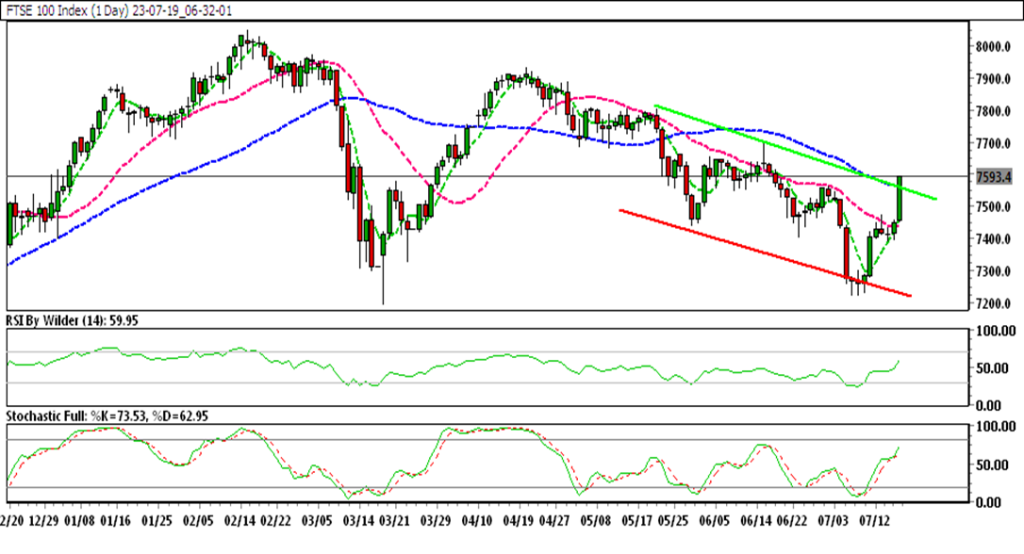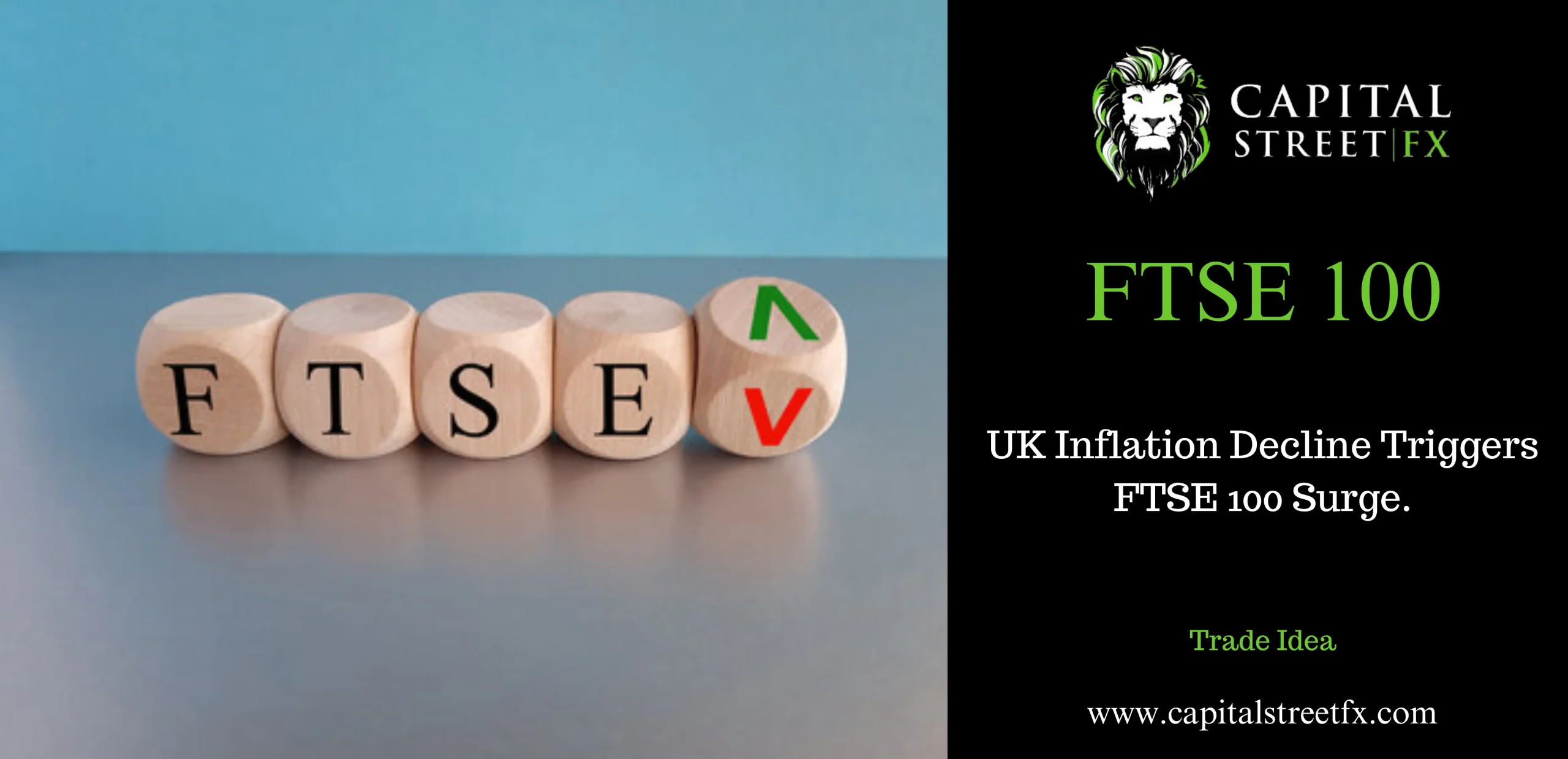UK Inflation Decline Triggers FTSE 100 Surge.
Introduction
In a surprising turn of events, the UK inflation rate witnessed a decline, leading to a notable surge in the FTSE 100. The pound, however, experienced a decline due to this development. European stocks, on the other hand, saw a rise following the lower-than-expected reading on UK inflation. Let’s delve into the details and understand the impact of this significant economic shift.
FTSE 100 Records 1.6% Gains Amidst Slower UK Inflation
At 7 a.m. BST, the U.K. consumer price index numbers revealed that the annual headline inflation stood at 7.9%. This figure was lower than the consensus estimate of 8.2% and marked a decline from the 8.7% recorded in May. As a result, the FTSE 100 experienced a notable surge of 1.6%, demonstrating the market’s positive response to the inflation decline.
Core CPI and Inflation for Services Also Witness a Decrease
The core consumer price index (CPI) also came in at 6.9%, falling below the forecasted level of 7.1%. The decline in core inflation was significant and contributed to the overall slowdown in UK inflation. Similarly, inflation for services followed suit and showed a decrease, further supporting the market’s optimistic reaction.
Market Sentiment: UK Home Builders’ Stocks Rise
One interesting outcome of the lower inflation statistics was the increase in shares of UK home builders. Markets adjusted their predictions for peak rates, now expecting it to be around 5.75%, as opposed to the previous 6%. This shift in market sentiment positively impacted the stocks of UK home builders, providing a boost to the overall market.
Continued High Inflation in the UK
Despite the decline in inflation, the annual consumer price inflation rate in the UK remained high at 7.9% in June. Though it was lower than the consensus expectation of 8.2%, the figure still reflects the ongoing inflationary pressures in the country. The core inflation, which was expected to stay at 7.1%, came in at 6.9%, remaining at an alarmingly high level.
Services Inflation Moderates
While overall inflation declined, the annual inflation rate for services showed a modest decrease from 7.4% to 7.2%. Though it was not as substantial as some might have hoped, the moderation in services inflation still provided some relief amid the prevailing economic challenges.
Profit Warnings on the Rise Amidst Interest Rate Uncertainty
With interest rates wreaking havoc on the market, UK-listed corporations faced a surge in profit warnings. According to a report by EY-Parthenon, between April and June of this year, public corporations issued a total of 66 profit warnings. This marked the longest stretch of profit warnings since 2008, with warnings increasing year over year for the seventh consecutive quarter.
FTSE 100 Technical Analysis: Key Factors to Consider
FTSE 100 Trading in a Down Channel
The FTSE 100 is currently trading within a down channel, indicating a bearish trend in the market. Traders and investors should carefully monitor the price movement and exercise caution while making trading decisions.
FTSE 100 Trading Above All SMA
Despite the bearish trend, the FTSE 100 is still trading above all its Simple Moving Averages (SMA). This suggests a certain degree of strength in the market and might indicate a potential for a rebound.
RSI in Buying Zone, Stochastic Signals Positive Trend
The Relative Strength Index (RSI) is currently in the buying zone, signaling a bullish outlook for the FTSE 100. Additionally, the Stochastic indicator also suggests a positive trend in the market.
Crucial Levels to Watch
Immediate resistance for the FTSE 100 is at 7625.7, while its immediate support level stands at 7566.5. Traders should closely monitor these levels as they can be crucial in determining the market’s next direction.
How to Trade FTSE 100 This Week

FTSE 100’s Recent Trend Reversal
After experiencing a strong decline and subsequent correction, the FTSE 100 has now changed course and is trading higher. This reversal might present trading opportunities for investors, but caution should be exercised given the market’s recent volatility.
Crucial Resistance Zone to Break Through
Currently, the FTSE 100 is trading in a crucial resistance zone. Traders should closely monitor the market’s behavior around this zone as a successful breakthrough could signal further upside potential.
Trade Suggestion: Buy at 7648.4, Target at 7710.7, SL at 7602.5
For traders looking to capitalize on the potential upside, a suggested trade involves buying at 7648.4 and setting a target at 7710.7. To manage risk, a stop loss can be placed at 7602.5.
Conclusion
The UK’s lower inflation rate has had a significant impact on the financial landscape, causing a surge in the FTSE 100 and altering market predictions for various sectors. Despite the decline, inflation remains a concern, and the uncertainty surrounding interest rates has led to increased profit warnings. Traders should carefully assess technical factors and market behavior before making trading decisions on the FTSE 100. As always, it is crucial to exercise caution and stay informed to navigate these volatile economic times successfully.

